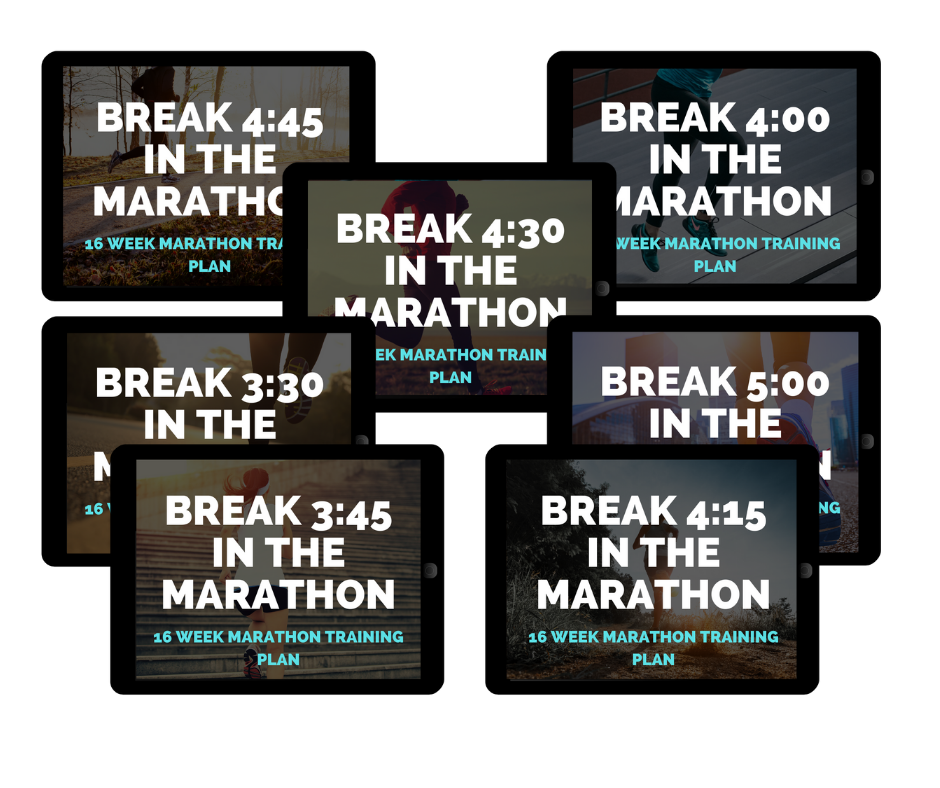Training for a Marathon Using Heart Rate Zones Plans
Alright, everyone - time to leave the twilight zone, the danger zone or at least your comfort zone and zone in on using heart rate zones for your next marathon or half marathon training.
And by leaving your comfort zone, I don’t mean that marathon training heart rate zones is a difficult method but just that the later zones (looking at you zones 4 and 5) will have you huffing and puffing.
No comfort there.
Heart rate zone training utilizes your heart rate to be able to tweak your training plan according to your personal capabilities.
Sounds ideal, right?
Having a plan specific to you sounds like a no brainer.
Utilizing your heart rate in predetermined zones enables you to train smartly at various levels.
The intensity of your workout is based on your heart data resulting in a personalized and enhanced performance.
But - how to know how and when to use your heart rate data? Well, that’s where knowing about the specific heart rate zones comes in handy.
This article will fill you in on all you need to know about the different zones so you can apply it to your marathon training plan.
Specifically we will talk about:
- the benefits of training by heart rate zones
- how to find your max heart rate so that you can guage what your heart rate should be for each specific zone level
- specifics on each heart rate zone
- how to know which zone to train in
- equipment needed to train using heart rate
- factors that might influence your heart rate training
And just what are heart rate zones?
Before explaining heart rate zones, it is necessary to first address heart rate training (or, sometimes referred to as HR training).
Heart rate training is a method of marathon preparation that utilizes your heart rate (the number of times your heart beats each minute) as a measurement to effectively achieve the proper intensity when exercising.
A heart rate monitor is employed to provide this heart data enabling you to train at a specific intensity according to your goals.
Using your heart rate is a great way to get feedback regarding how hard you are working which can be useful for monitoring your running workouts.
Now, about heart rate zones:
Traditional heart rate zones are five organized levels (zones) of training with each zone (or level) possessing a specific range of exertion.
Each level is structured to gradually increase in intensity and to accomplish different objectives.

Using your maximum heart rate (max hr), you are able to calculate your personal range of exertion that is to be implemented in your workout.
Maximum heart rate is: the highest number your heart beats while undergoing maximum exertion. It’s in applying your maximum heart rate number that lands you in a certain zone.
Although there are some slight variances in online zone charts, the zones all start with exertion ranges that require very light effort exerted during exercise and gradually increase to maximum effort exerted while exercising.
Choosing which zone to perform a workout in depends on your daily goal.
Benefits of Heart Rate Zone Training
Basically, using this technique enables you to monitor and fine tune the intensity of your workouts according to your personal heart data.
Training sessions are more efficient and goals are reached more effectively.
Need to know more specific benefits? Read on:
- Heart rate training enables you to customize your workouts according to the intensity desired.
- Your target heart rate zones provide clear and concrete objectives. Guesswork is eliminated.
- Consistent exertion throughout your workout is likely when remaining in your zone.
- Injury risk is lowered and workouts are safer as your targeted zone keeps you in a certain range. Overtaxing your body and especially your heart is reduced.
- Overtraining and underperforming is unlikely as your objective is straightforward.
- Fatigue is reduced as you’re implementing personal heart data.
- Workouts can be easily tracked.
- Motivation peaks with the challenge of staying in your desired zone.
- Necessary adjustments due to unexpected occurrences can be easily implemented.
The Specific Heart Rate Zones
Below is a rundown of each zone followed by a section on how to know in which zone you should be planning your training runs.
Zone 1 - Very Low Intensity
The first level zone is the lowest intensity zone.
At this level, you’re exercising at 50 to 60 percent of your maximum heart rate.
Your workout is quite light without much effort required.
Most workouts begin (with a warm up) and end (with a cool down) at this level but you’ll also want to target this zone for your entire workout session at times when recovery is necessary.
Jumping into this zone in between intervals when interval training for recovery is another time you’ll want to be in zone 1.
With the low intensity of this zone, it’s a good starting point for new runners.

Zone 2 - Light Intensity
Zone 2 is still employing a quite comfortable pace. Your exertion at this level should be roughly 60 to 70 percent of your max hr.
A long easy run is the target in Zone 2.
Carrying on a conversation with your running partner should be effortless. Overall endurance is improved allowing you to eventually run faster without much exertion.
Zone 2 is where most preparation takes place.
Although the intensity is still light while running the longer distance, elite athletes find it challenging for that very reason.
Holding back when feeling good is a difficult, but necessary, feat.
Necessary because this easier training improves overall speed and stamina. I know, I know - improves speed while running slower?
Yep.
What happens is when you implement zone 2 training consistently, you’ll find you will eventually be able to run at a faster pace while preserving your zone 2 heart rate. Pretty sweet, huh?
The aerobic fitness that is a result of training in this zone benefits the cardiovascular system making you stronger and fitter.

Zone 3 - Moderate Intensity
Starting to feel a little uncomfortable while running in zone 3?
You should, although not so much that you can’t sustain your speed for an hour with 30 to 45 minutes being the average duration.
70
to 80 percent of your maximum heart rate is the goal in this more
challenging zone.
Here are some changes that happen in this heart rate zone:
- Speed, strength and stamina are improved making runs more efficient.
- Blood flow is also improved at this level, bringing oxygen and nutrients to those hard-working muscles.
- Breathing is more laborious, making conversation more difficult.
- Speed, strength and stamina are improved making runs more efficient.
- Blood flow is also improved at this level, bringing oxygen and nutrients to those hard-working muscles.

Zone 4 - Difficult Intensity
This is the zone where long interval running happens.
It’s definitely challenging and you’re going to have to really push to get through the training session.
80 to 90 percent or your maximum heart rate is being exerted. It is here that you reach your anaerobic threshold meaning oxygen isn’t enough to fuel the muscles at this intensity so carbs are used instead.
Lactic acid can accumulate when you go over your anaerobic threshold although relatively recent studies show this isn’t necessarily as bad as previously thought.
The cramps, burning pain and heaviness that were previously blamed on lactic acid accumulation is actually caused by hydrogen acidic ions that are formed at the time lactate molecules are produced.
Yes, I realize this is just shifting the blame and that the end results still exist but using the correct terminology can help going forward by correctly understanding the actual process.
With that said, minimizing the lactic acid buildup and hence, the hydrogen ions that cause you to slow down at this level, is possible.
By doing the bulk of your training runs in zone 2, you will be improving your aerobic capacity which in turn positively affects the distance and speed at which you can run.
Zone 4 training sessions will benefit from those workouts as it’s all about speed and endurance.
-And, anyway, complaining about any aches and pains while in this zone won’t happen because conversation isn’t happening. See how that works. :)

Zone 5 - Maximum Intensity
Going all out is the name of the game in this zone.
You, and your heart, of course, will be working at your maximum capacity (90 to 100 percent).
This level is generally incorporated into training programs by serious marathon or half marathon runners - so beginner runners probably won’t put in much time at this level.
Because of the intensity, you’ll only be able to do intense short intervals - and not for a long time either. Sprinting is usually the target meaning using maximum speed in short bursts.
-And at this level, don’t expect to control your lactic acid. Lactic acid builds up so fast your body can’t process it - although you can condition your body to tolerate it.
Working at this level means proper recovery is essential. Neglect proper recovery and you will stress your body by the over performance which results in underperforming. Even injury and illness is at risk.
The benefits: Drills in this zone will improve your
- maximum sprinting speed,
- enhance reaction time,
- improve your stamina,
- strengthen your muscles and
- enable you to workout with high intensity
You’ll also be able to use this pace to boost your speed when the finish line is in sight.

How to Know Which Zone to Train In
Most marathon training is done in the lower zones of 1 and 2.
The other zone levels are to be used occasionally to aid in the building of stamina, strength, speed and endurance.
You’ll want to target heart rate zones according to your running goals.

Warm Ups, Cool Downs, Recovery Runs
- Zone 1
You’ll use this zone every time you have a scheduled run as it’s used before and after each workout.
You’ll also want to stay in this zone if you recently had an intense workout or if you’re at the tail-end of recovery from a marathon or half marathon.
Having easy days at this time will provide time for body repairs. Running at this slow, easy pace for about 40 minutes should be sufficient.

The Long Run - Zone 2 and Possibly 3
When following a marathon plan, longer runs should stick to zone 2 and possibly the lower spectrum of zone 3.
Running at 70% (up to 80%) of your max hr is the best way for building endurance and stamina.
-And by longer runs, I’m talking about runs that exceed 10 to 12 miles or 2 hours in duration. Long runs should be implemented every 7 to 10 days.
For more detailed information in regards to what pace you should be running during a long run, see this page.

Moderate Runs, tempo runs (aka lactic acid runs) - Zone 3
As stated above, maintaining your pace for about an hour is about all that will be possible.
Scheduling a run for 25 to 60 minutes is advised here or break up the workout by implementing zone 1 recovery runs in between several 15 minute segments.
Avoid doing easy runs in this zone as it will result in overtraining. In fact, don’t conduct most of your training sessions in this zone.
Zealous runners tend to make the mistake of exercising at this level too much because this more challenging level mentally makes you feel like you’re accomplishing great things.
Now, don’t get me wrong, zone 3 definitely has its benefits. Here, strength and stamina will be improved which means, over time, you’ll notice your efforts paying off with your workouts being easier.
However, by continually having your training intensity in zone 3, you run harder than is necessary - preventing your body from getting adequate recovery.
Instead, your body is more stressed which negates all of the benefits. So the somewhat hard run in this zone is fine but just don’t do it more often than working out in zone 2.
Veteran marathon runners will probably run their marathon in zone 3 so as race day approaches, workouts in this zone should increase in order to mimic the marathon pace.
The classic training run that would be in zone 3 of marathon training heart rate zones would be the tempo run (also known as the lactic acid run). Here is a guide to tempo running.

Long Interval Training - Zone 4
Now to the tough training.
This zone implements fast shorter distances with recovery runs (Zone 1) in between.
Try workouts that last 2 to 10 minutes and implement two to three times per week for best results.
Most of the interval training workouts that marathon and half marathon runners perform will be in this heart rate zone as they should be running half mile to full mile interval repeats.
Here is a guide to interval running as a marathoner or half marathoner.

Speed Intervals - Zone 5
As stated above, maximum effort is exerted at this level; however, the good news about this intense zone: duration is short - usually about a minute or two but definitely no more than four minutes, depending on your fitness level.
To implement speed work, one simple approach among many different ways is to run at your super fast speed (sprint pace) for no longer than 4 minutes.
Initially, do four repetitions and increase by one for subsequent workouts. If at first you struggle with keeping this fast pace for 4 minutes, lessen your time and build up.
Generally, only 1 to 2 speed interval workouts a week are suggested.
As a marathon runner, I like to do add-on sprints called strides during an easy run or during taper week when trying to keep pace gains made during training.
In fact this is why I include strides into all of the Break a Time Goal 16 Week Marathon Training Plans.
Equipment Needed
Smartwatch
Obviously, to use the zone technique, you’ll need to track your heartbeat. The easiest way to do this is by using your smartwatch. (See this article if you need help choosing one!)
At the very least, most smartwatches will supply your current heart rate.
Newer models and more advanced models provide preprogrammed heart rate zones or allow you to set up the zones for yourself.

The Heart Rate Monitor
If your watch doesn’t have a built-in monitor, purchasing a separate heart rate monitor that fits on your arm, ear or chest will be needed.
While chest straps provide the most accuracy, armband models win in the convenience department. Just make sure your monitor is attached securely to get the best readouts.
Here’s a highly rated chest strap from Polar for consideration.
And an armband monitor from Powr Labs.
Earbud heart rate monitors are growing in popularity although fitting these to provide a snug fit for continual accurate readings, while maintaining comfort, can be challenging. Interested?
This Bose pair is a little pricey but remember, these earbuds do more than track your heart rate. -And you know the sound quality of Bose is always top notch.
The data collected by these strap-on or in the ear contraptions is then transmitted to your watch enabling you to gauge your beating heart throughout your workout.
Once you figure out your maximum heart rate and apply it to the various zones, you are then all set to use the monitor tracking device of your choice and implement while training.
Calculating Your Maximum Heart Rate
Following are three methods of figuring out your max heart rate.
Figure out this number, plug it into each zone to calculate your personal goals and you're good to go.
Using a Formula
Yes, you’ll have to employ some Math skills here - but don’t tune out yet. Rest assured they’re simple Math tasks.
While this is not the most accurate way of finding your max heart rate, this number will get you fairly close.
The following equation is derived from what’s known as Haskell’s equation and fine-tuned using the Tanaka formula.
This number will get you fairly close to accuracy.
206.9 - (0.67 x your age) = Max HR

The Lab Stress Test
Having your medical provider or cardiologist conduct a lab stress test is going to be the most accurate method.
In the lab, you will perform tasks that increase your heart rate until you reach your limit.
Besides the benefit of getting accurate results, some find it quite comforting having a supervised test when pushing yourself to these extreme limits.
In addition to the advantage of having a professional manage your test, another plus of this method is you will also gather other data such as your lactate threshold (The point when lactate is building up faster than the body is able to remove it.) and your oxygen intake data.

Field Test
This is a test you can perform on your own.
Do be aware, however, that obtaining your maximum heart rate requires you to push to your maximum intensity level.
Therefore, it should only be done if you are in excellent health.
This means no recent illnesses and injuries. You also want to be well rested so no recent races. It is also recommended that you have running experience and are active for at least three hours per week.
You’ll find there are several variations of the field test.
The following is a common and simple method and only requires the use of a heart rate monitor.
- First of all, start by warming up. Run 1 to 3 miles according to your fitness level.
- Next, run an additional mile at what’s known as tempo pace. (Tempo runs consist of moderate to difficult exertion runs.) When you have about one lap remaining (if running on a track - or about 400 meters), run at a fairly intense clip.
- Then, for the last 100 meters (or in other words, the last ¼ of this lap on the track), sprint as fast as possible.
- When you reach the end, and can’t run any harder, view the heart rate data provided for that last 400 meters. Your maximum heart rate will be the highest number displayed.
If you want to perform a running fitness test instead of a heart rate test then see this guide.

Temporary Factors that Influence your Heart Rate Data
Keep in mind that a variety of factors can cause variations in your heart rate.
Being mindful of possibilities might provide explanations of questionable performance.
Some of the more common influencing factors to be aware of include:
- humidity and other weather elements,
- medications,
- dehydration,
- stress,
- illnesses,
- allergies,
- caffeine,
- insufficient recovery,
- medications,
- elevation,
- dehydration, and
- sleep deprivation
It is helpful to observe data over a month (or even a week) rather than analyzing one given day.
Be aware that working out over your maximum heart rate is never advised.
Of course, if you experience chest pain, dizziness, nausea and/or faintness, calling 911 is advised.
Summary
With the overall conditioning that heart rate zones provide for endurance athletes, this approach is definitely worth a shot to see if it’s a method you’ll want to consistently set in motion.
A better, more precise workout is ensured making you a better runner and well prepared for marathon race day.
While aiming for optimal fitness using heart data, it’s a good idea to also track your resting heart rate and your average heart rate for total insight.
Also checking out this article will provide more heart rate info.
Okay, all done. Now you are allowed to zone out.
Related Pages:
👋Sign up to receive the free printable strength exercises for runners: 👇
 |
Your second block of text...
As featured on:













New! Comments
Have your say about what you just read! Leave me a comment in the box below.